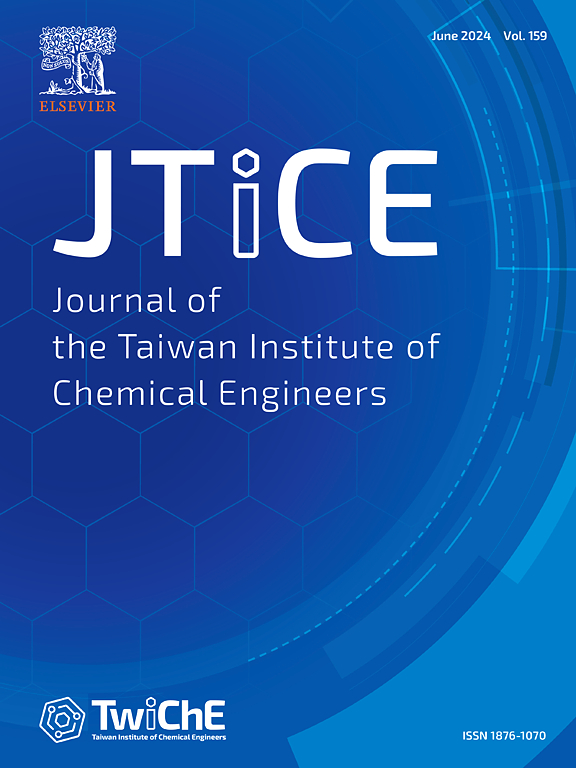Investigation of toluene-methyl isobutyl ketone mixed solvents as extractants for efficient separating ethylene carbonate from ethylene glycol
IF 5.5
3区 工程技术
Q1 ENGINEERING, CHEMICAL
Journal of the Taiwan Institute of Chemical Engineers
Pub Date : 2025-03-29
DOI:10.1016/j.jtice.2025.106113
引用次数: 0
Abstract
Background
The separation of value-added glycerol carbonate, versatile commercial ethylene glycol (EG), and residual ethylene carbonate (EC) is crucial for further application after transesterification of glycerol and EC. However, the EC and EG form an azeotropic mixture, which cannot be separated by conventional distillation methods.
Methods
To separate EC-EG azeotropic mixture, a mixed extractant of toluene and methyl isobutyl ketone (MIBK) was developed to extract EG and EC by liquid-liquid extraction. The selection of suitable extractants with high selectivity (S) and distribution coefficient (D) is key to achieving efficient separation. Herein, to evaluate the feasibility of extractive separation of EG and EC, the corresponding liquid−liquid equilibrium (LLE) data were measured at 313.2 K under atmospheric pressure.
Significant findings
The mixed extractant showed higher D than toluene alone and higher S than MIBK alone, which makes it a more suitable extractant for separating the EC-EG mixture. In addition, the radial distribution function showed that the peak height g(r) between extractants (MIBK and toluene) and EC (1.58–1.83) was higher than that between extractants and EG (1.01–1.15), suggesting that toluene and MIBK preferentially extracted EC from the EC-EG mixture. Herein, this study provided an effective strategy for separating EC and EG after transesterification of glycerol and EC.

甲苯-甲基异丁基酮混合溶剂萃取分离碳酸乙烯和乙二醇的研究
增值碳酸甘油、通用商用乙二醇(EG)和残余碳酸乙烯(EC)的分离对于甘油和EC酯交换后的进一步应用至关重要。然而,EC和EG形成一种共沸混合物,不能通过传统的蒸馏方法分离。方法为分离EC-EG共沸混合物,研制了甲苯-甲基异丁基酮(MIBK)混合萃取剂,采用液-液萃取法提取EG和EC。选择具有高选择性(S)和高分配系数(D)的萃取剂是实现高效分离的关键。为了评估萃取分离EG和EC的可行性,在313.2 K常压下测量了相应的液-液平衡(LLE)数据。混合萃取剂的D值高于单独甲苯,S值高于单独MIBK,是分离EC-EG混合物的更合适的萃取剂。此外,径向分布函数表明,萃取剂(MIBK和甲苯)与EC之间的峰高g(r)(1.58 ~ 1.83)高于萃取剂与EG之间的峰高g(r)(1.01 ~ 1.15),说明甲苯和MIBK优先从EC-EG混合物中萃取EC。本研究为甘油和EC酯交换后分离EC和EG提供了有效的策略。
本文章由计算机程序翻译,如有差异,请以英文原文为准。
求助全文
约1分钟内获得全文
求助全文
来源期刊
CiteScore
9.10
自引率
14.00%
发文量
362
审稿时长
35 days
期刊介绍:
Journal of the Taiwan Institute of Chemical Engineers (formerly known as Journal of the Chinese Institute of Chemical Engineers) publishes original works, from fundamental principles to practical applications, in the broad field of chemical engineering with special focus on three aspects: Chemical and Biomolecular Science and Technology, Energy and Environmental Science and Technology, and Materials Science and Technology. Authors should choose for their manuscript an appropriate aspect section and a few related classifications when submitting to the journal online.

 求助内容:
求助内容: 应助结果提醒方式:
应助结果提醒方式:


